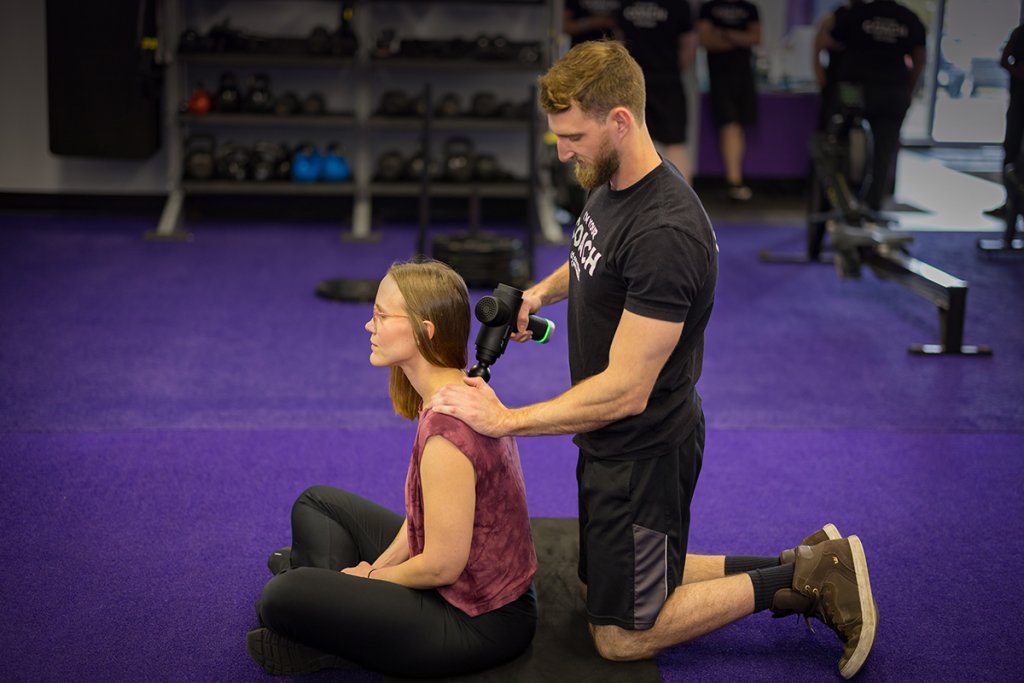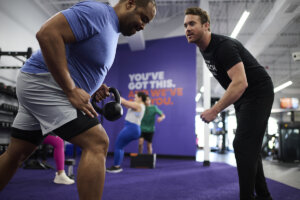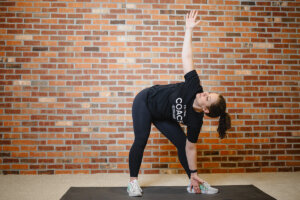Percussion tools have quickly become one of the most popular recovery tools for their ability to help relax tense muscles, increase blood flow, alleviate soreness, and calm the nervous system.
You can get the restorative power of percussion tools at many Anytime Fitness locations across the U.S. to help maximize your pre- and post-workout recovery. Let’s take a closer look at percussion tools, how they can help recovery, and the best uses for them.
What are percussion tools and what do they do?
Most percussion tools are handheld with interchangeable attachments to address certain areas of the body and provide different effects — from light vibration to deep tissue percussion. Their range in power is vast, with tools delivering anywhere from 1,800 to more than 3,000 percussions per minute.
In a 2023 study examining the effects of massage guns on performance and recovery, percussion tools were found to be effective in improving flexibility in hamstrings, triceps, and the posterior chain (aka back of legs and spine). The tools also helped improve short-term range of motion and reduced stiffness and muscle fatigue.
While percussion tools are safe to use on your own, our Coaches are trained to help you incorporate the tools into your workout routine to maximize everyday recovery.
How do percussion tools help with muscle recovery?
Using a percussion device on your muscles helps relieve soreness and tension — therefore improving movement quality — in three ways.
- First, these tools use vibrations to create motion in your skin, muscles, and fascia (connective tissue that surrounds your muscles and bones).
- The beats also increase blood flow and help reduce inflammation. In this way, the percussion tool is mechanically affecting your body in ways you can really feel.
- The vibrations can help break up the pain signals sent by your brain to your body.
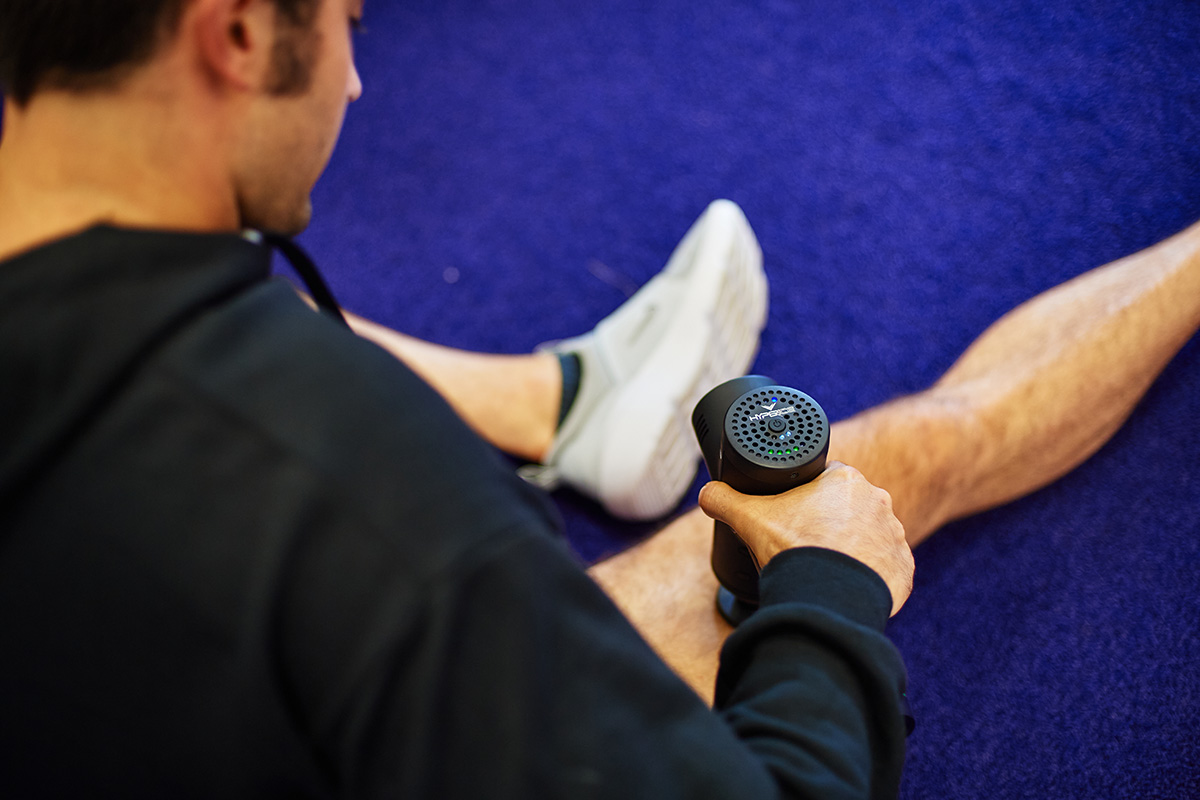
Reducing soreness
Ever had a workout that you could feel the next day, and the next, and the next? No matter how hard you try, you simply can’t forget about that workout every time you move a muscle. You’re experiencing delayed onset muscle soreness (commonly referred to as DOMS) and, well, the name really explains it all. The soreness sets in, but not until later, when your tissues have cooled down and you’ve moved on with your life (or at least tried to!).
Using a percussion instrument on a low setting for 1 to 2 minutes on the affected areas can help relieve DOMS. Don’t forget to breathe deeply.
Relieving tension
Sometimes muscles and joints aren’t so much sore as they are tight. Using a foam roller is fantastic for relieving tension and addressing tight spots, but adding percussion brings self-myofascial release to a new level.
Tension is often held in the myofascia rather than the actual muscle itself. The stimulation of percussion can help provide relief by breaking up trigger points (aka knots) in the myofascia — the layer of connective tissue that surrounds muscle.
What percussion tools are used at Anytime Fitness?
There are two major manufacturers of handheld percussion devices, Hyperice and Therabody, which are what we use in our gyms. Hyperice makes the Hypervolt models, and Therabody makes the Theragun models. In a survey of 425 practitioners in the health and fitness industry, 92% of those that use percussion tools choose from these two companies.
The differences between the two models come down to personal preference and what you’re looking to achieve with percussion therapy. Availability varies by location.
When are percussion tools most effective?
One of the many benefits of percussion tools is that it’s versatile enough to use anytime — it just depends on what effects you’re looking for in your recovery routine.
Before your workout
Use a percussion tool as part of your warm-up routine to help increase blood flow and mobility. By using percussion in your warmup, movement quality can be improved, such as an increased range of motion or more fluid movement patterns. This may lead to better exercise movements like squatting or pulling. With consistency, the quality of the movement may last longer, allowing you to get more out of your workout.
After your workout
Targeting the muscle groups used in your workout may help give your recovery a big boost. Percussion increases blood flow, and after a workout, your blood is rich with oxygen and nutrients to fuel your tissues and help them repair. Use the percussion device on the target areas for no more than 2 minutes each for the most benefit.
What happens during a percussion session at Anytime Fitness?
If you’re ready to see these tools in action and add them to your recovery routine, percussion sessions with a Coach at Anytime Fitness may be right for you. Here’s what to expect:
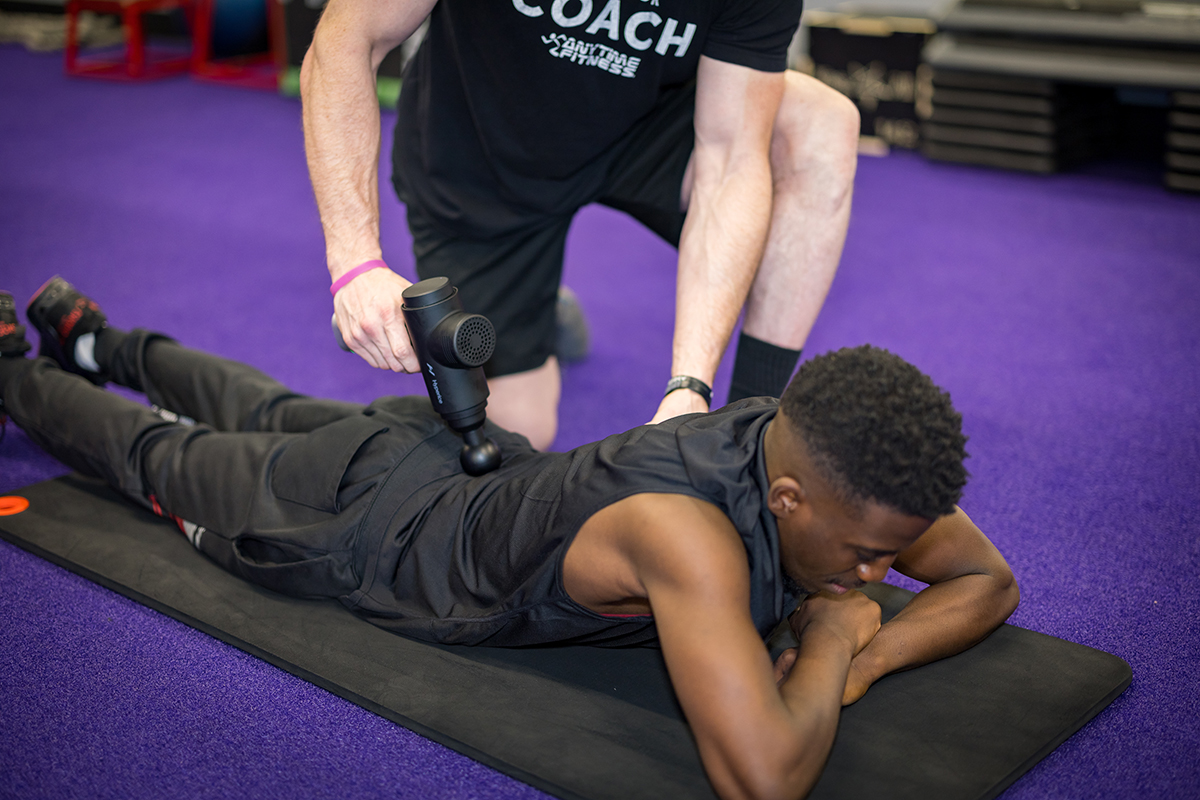
1. Movement & Stress Assessment
Your Coach will talk with you to understand what you are hoping to achieve with your percussion sessions and may include a movement assessment and discussion of where you are feeling tension or stress in your body.
2. Percussion Work
Based on your assessment, your Coach will focus on a few areas of the body to work on with the percussion tool, using various techniques.
3. Reassessment
After the percussion work, your Coach will discuss and assess any change you are noticing or feeling.
4. Mindfulness Moment
Your Coach will guide you through a mindfulness or breathwork moment and give you a recovery task to focus on before your next session..
When should percussion be avoided?
While the use of percussion tools is considered safe for most people, there are certain situations in which you should avoid them. Avoid using percussion tools if you are experiencing any of the following:
- Skin rash or open wounds
- Bone concerns such as osteoporosis
- Recent bone injuries
- Neurological conditions such as multiple sclerosis
- Diabetes
- Deep vein thrombosis
- Pain or discomfort in the area
- Cancer
- Viral or bacterial infection
- Fever or contagious condition
- Bleeding disorders (e.g., hemophilia)
- Medications that alter sensation or thin blood
- Recent surgery or tissue injury
- Sensitivity to vibration, percussion, or sounds
A final word on using percussion tools for better, faster recovery
Now that we’ve covered the basics of percussion tools, it’s time for you to experience the benefits yourself before or after a workout with the help of a Coach. Prioritizing recovery and different tools like percussion guns will set you up for success throughout your wellness journey — one healing vibration at a time.
Learn more about the essential role recovery plays in your wellness routine and how to make recovery a part of everyday life.
